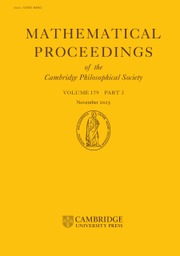Crossref Citations
This article has been cited by the following publications. This list is generated based on data provided by
Crossref.
Kaempffer, F. A.
1955.
SOME CONSIDERATIONS REGARDING THE PRINCIPLE OF PHASE INVARIANCE.
Canadian Journal of Physics,
Vol. 33,
Issue. 8,
p.
436.
Bohm, D.
Schiller, R.
and
Tiomno, J.
1955.
A causal interpretation of the pauli equation (A).
Il Nuovo Cimento,
Vol. 1,
Issue. S1,
p.
48.
Buneman, O.
1957.
Circulation — clue to a unified theory?.
Il Nuovo Cimento,
Vol. 5,
Issue. S1,
p.
92.
Buneman, O.
1958.
Transverse Plasma Waves and Plasma Vortices.
Physical Review,
Vol. 112,
Issue. 5,
p.
1504.
LOMAX, R. J.
1958.
Single Component Relativistic Space-Charge Flow.
Journal of Electronics and Control,
Vol. 5,
Issue. 6,
p.
563.
BUNEMAN, O.
1958.
The Non-existence of Straight, Parallel, Compressible Space-Charge Flow.
Journal of Electronics and Control,
Vol. 5,
Issue. 6,
p.
561.
BUNEMAN, O.
1961.
Crossed-field Microwave Device.
p.
209.
BIRTLES, A. B.
1972.
Relativistic space-charge flow patterns†.
International Journal of Electronics,
Vol. 33,
Issue. 4,
p.
437.
Antonsen, Thomas M.
and
Ott, Edward
1976.
Theory of intense ion beam acceleration.
The Physics of Fluids,
Vol. 19,
Issue. 1,
p.
52.
Swegle, John
and
Ott, Edward
1981.
Instability of the Brillouin-Flow Equilibrium in Magnetically Insulated Structures.
Physical Review Letters,
Vol. 46,
Issue. 14,
p.
929.
Swegle, John
and
Ott, Edward
1981.
Linear waves and instabilities on magnetically insulated gaps.
The Physics of Fluids,
Vol. 24,
Issue. 10,
p.
1821.
Swegle, John
and
Ott, Edward
1981.
Equilibrium for cylindrical, magnetically insulated ion diodes assuming adiabatic turn-on.
The Physics of Fluids,
Vol. 24,
Issue. 1,
p.
158.
Swegle, J. A.
1982.
Nonexistence of quasilaminar equilibria in cylindrical magnetically insulated lines.
The Physics of Fluids,
Vol. 25,
Issue. 7,
p.
1282.
Swegle, John
and
Ott, Edward
1982.
Long Wavelength, Nonlinear Perturbations of the Brillouin Flow Equilibrium on Magnetically Insulated Lines.
IEEE Transactions on Plasma Science,
Vol. 10,
Issue. 1,
p.
33.
Forslund, D. W.
and
Brackbill, J. U.
1982.
Magnetic-Field-Induced Surface Transport on Laser-Irradiated Foils.
Physical Review Letters,
Vol. 48,
Issue. 23,
p.
1614.
Swegle, John
1983.
Stability of relativistic laminar flow equilibria for electrons drifting in crossed fields.
The Physics of Fluids,
Vol. 26,
Issue. 6,
p.
1670.
BALLARD, W. P.
SELF, S. A.
and
CRAWFORD, F. W.
1983.
Theoretical considerations for relativistic magnetrons.
International Journal of Electronics,
Vol. 55,
Issue. 5,
p.
687.
Davidson, Ronald C.
Tsang, Kang
and
Swegle, John A.
1984.
Macroscopic extraordinary-mode stability properties of relativistic non-neutral electron flow in a planar diode with applied magnetic field.
The Physics of Fluids,
Vol. 27,
Issue. 9,
p.
2332.
Chang, C. L.
Antonsen, Thomas M.
Ott, Edward
and
Drobot, Adam T.
1984.
Instabilities in magnetically insulated gaps with resistive electrode plasmas.
The Physics of Fluids,
Vol. 27,
Issue. 10,
p.
2545.
Mendel, C. W.
Swegle, J. A.
and
Seidel, D. B.
1985.
Stability of magnetically insulated electron flow.
Physical Review A,
Vol. 32,
Issue. 2,
p.
1091.

